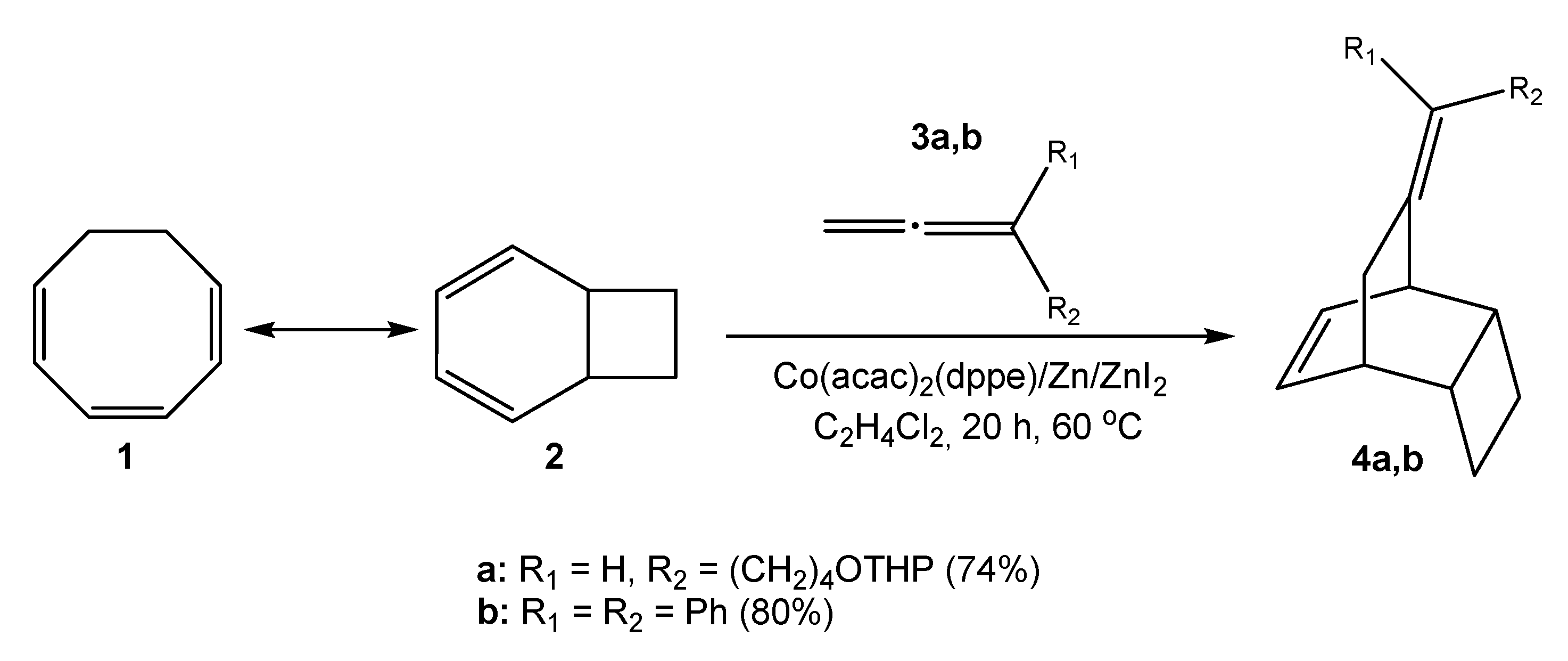Co(I)-Catalyzed [4π + 2π] Cycloaddition of 1,2-Dienes to 1,3,5-Cyclooctatriene in the Synthesis of Previously Undescribed Tricyclo[4.2.2.02,5]Decenes †
Abstract
:1. Introduction
2. Results and Discussion
3. Conclusions
4. Experimental Part
Author Contributions
Funding
Institutional Review Board Statement
Informed Consent Statement
Data Availability Statement
Acknowledgments
Conflicts of Interest
References
- Petasis:, N.A.; Patane, M.A. The Synthesis of Carbocyclic Eight-Membered Rings. Tetrahedron 1992, 48, 5757–5821. [Google Scholar] [CrossRef]
- D’yakonov, V.A.; Kadikova, G.N.; Dzhemilev, U.M. Transition Metal Complex-Mediated Chemistry of 1,3,5-Cycloheptatrienes. Russ. Chem. Rev. 2018, 87, 797–820. [Google Scholar] [CrossRef]
- Yu, Z.X.; Wang, Y.; Wang, Y. Transition-metal-catalyzed cycloadditions for the synthesis of eight-membered carbocycles. Chem. Asian J. 2010, 5, 1072–1088. [Google Scholar] [CrossRef] [PubMed]
- Fruhauf, H. Metal-assisted cycloaddition reactions in organotransition metal chemistry. Chem. Rev. 1997, 97, 523–596. [Google Scholar] [CrossRef] [PubMed] [Green Version]
- Lautens, M.; Klute, W.; Tam, W. Transition metal-mediated cycloaddition reactions. Chem. Rev. 1996, 96, 49–92. [Google Scholar] [CrossRef] [PubMed]
- Anand, A.; Singh, P.; Kumar, V.; Bhargava, G. Transition metal catalyzed [6 + 2] cycloadditions. RSC Adv. 2019, 9, 25554–25568. [Google Scholar] [CrossRef] [Green Version]
- Schmidt, T. Molybdenum-catalysed and -mediated cycloaddition reactions: Efficient synthesis of complex products from 1-oxa-l,3-dienes and cyclotrienes or -tetraenes. Chem. Ber. 1997, 130, 453–461. [Google Scholar] [CrossRef]
- Achard, M.; Mosrin, M.; Tenaglia, A.; Buono, G. Cobalt(I)-Catalyzed [6 + 2] Cycloadditions of Cyclooctatetra(tri)ene with Alkynes. J. Org. Chem. 2006, 71, 2907–2910. [Google Scholar] [CrossRef] [PubMed]
- Dyakonov, V.A.; Kadikova, G.N.; Nasretdinov, R.N.; Dzhemilev, U.M. Cobalt(I)-catalyzed [4π + 2π] cycloaddition reactions of 1,3-diynes with 1,3,5-cyclooctatriene. Tetrahedron Lett. 2017, 58, 1839–1841. [Google Scholar] [CrossRef]
- Dyakonov, V.A.; Kadikova, G.N.; Dzhemileva, L.U.; Gazizullina, G.F.; Ramazanov, I.R.; Dzhemilev, U.M. Cobalt-Catalyzed [6 + 2] Cycloaddition of Alkynes with 1,3,5,7-Cyclooctatetraene as a Key Element in the Direct Construction of Substituted Bicyclo[4.3.1]decanes. J. Org. Chem. 2017, 82, 471–480. [Google Scholar] [CrossRef] [PubMed]
- D’yakonov, V.A.; Kadikova, G.N.; Gazizullina, G.F.; Dzhemilev, U.M. Cobalt(I)-Catalyzed Cycloaddition of Functionally Substituted Alkynes and 1,3-Diynes to 1,3,5,7-Cyclooctatetraene in the Synthesis of Bicyclo[4.2.2]deca-2,4,7,9-tetraenes. ChemistrySelect. 2018, 3, 6221–6223. [Google Scholar] [CrossRef]
- D’yakonov, V.A.; Kadikova, G.N.; Nasretdinov, R.N.; Dzhemileva, L.U.; Dzhemilev, U.M. The Synthesis of Bicyclo[4.2.1]nona-2,4,7-trienes by [6π+2π]-Cycloaddition of 1-Substituted 1,3,5-Cycloheptatrienes Catalyzed by Titanium and Cobalt Complexes. J. Org. Chem. 2019, 84, 9058–9066. [Google Scholar] [CrossRef] [PubMed]
- D’yakonov, V.A.; Kadikova, G.N.; Nasretdinov, R.N.; Dzhemileva, L.U.; Dzhemilev, U.M. Targeted Synthesis of 9-Azabicyclo[4.2.1]nona-2,4,7-trienes by Cobalt(I)-Catalyzed [6π + 2π]-Cycloaddition of Alkynes to N-Substituted Azepines and Their Antitumor Activity. Eur. J. Org. Chem. 2020, 623–626. [Google Scholar] [CrossRef]
- Kadikova, G.N.; Dzhemileva, L.U.; D’yakonov, V.A.; Dzhemilev, U.M. Synthesis of Functionally Substituted Bicyclo[4.2.1]nona-2,4-dienes and Bicyclo[4.2.1]nona-2,4,7-trienes by Cobalt(I)-catalyzed [6π + 2π] Cycloaddition of 2-Tropylcyclohexanone. ACS Omega 2020, 5, 31440–31449. [Google Scholar] [CrossRef] [PubMed]
- Kadikova, G.N.; D’yakonov, V.A.; Dzhemilev, U.M. Synthesis of New Functionally Substituted 9-Azabicyclo[4.2.1]nona-2,4,7-trienes by Cobalt(I)-Catalyzed [6 + 2]-Cycloaddition of N-Carbocholesteroxyazepine to Alkynes. Molecules 2021, 26, 2932. [Google Scholar] [CrossRef] [PubMed]
- Cope, A.C.; Haven, A.C.; Ramp, F.L.; Trumbull, E.R. Cyclic Polyolefins. XXIII. Valence Tautomerism of 1,3,5-Cycloöctatriene and Bicyclo[4.2.0]octa-2,4-diene1. J. Am. Chem. Soc. 1952, 74, 4867–4871. [Google Scholar] [CrossRef]
- D’yakonov, V.A.; Kadikova, G.N.; Dzhemileva, L.U.; Gazizullina, G.F.; Yunusbaeva, M.M.; Dzhemilev, U.M. Oxidative skeletal rearrangement of bicyclo[4.2.2]deca-2,4,7,9-tetraenes to bicyclo[4.3.1]deca-2,4,8-triene-7,10-diols and study of the antitumor activity of the products in vitro. Tetrahedron 2018, 74, 4071–4077. [Google Scholar] [CrossRef]
- Cotton, F.A.; Faut, O.D.; Goodgame, M.L.; Holm, R.H. Magnetic Investigations of Spin-free Cobaltous Complexes. VI. Complexes Containing Phosphines and the Position of Phosphines in the Spectrochemical Series. J. Am. Chem. Soc. 1961, 83, 1780–1785. [Google Scholar] [CrossRef]
- Brandsma, L. Synthesis of Acetylenes, Allenes and Cumulenes: Methods and Techniques; Elsevier Academic Press: Bilthoven, The Netherlands, 2004; pp. 229–234. [Google Scholar]
- Oda, M.; Kawase, T.; Kurata, H. 1,3,5-cyclooctatriene. Org. Synth. 1996, 73, 240. [Google Scholar]

| Сompound | Jurkat | K562 | U937 | HL60 | Fibroblasts |
|---|---|---|---|---|---|
| 4a | 0.032 ± 0.003 | 0.029 ± 0.002 | 0.045 ± 0.004 | 0.028 ± 0.002 | 0.161 ± 0.020 |
| 4b | 0.026 ± 0.002 | 0.023 ± 0.002 | 0.031 ± 0.002 | 0.019 ± 0.002 | 0.158 ± 0.019 |
Publisher’s Note: MDPI stays neutral with regard to jurisdictional claims in published maps and institutional affiliations. |
© 2021 by the authors. Licensee MDPI, Basel, Switzerland. This article is an open access article distributed under the terms and conditions of the Creative Commons Attribution (CC BY) license (https://creativecommons.org/licenses/by/4.0/).
Share and Cite
Kadikova, G.N.; Dzhemileva, L.U.; Dzhemilev, U.M. Co(I)-Catalyzed [4π + 2π] Cycloaddition of 1,2-Dienes to 1,3,5-Cyclooctatriene in the Synthesis of Previously Undescribed Tricyclo[4.2.2.02,5]Decenes. Chem. Proc. 2022, 8, 47. https://doi.org/10.3390/ecsoc-25-11633
Kadikova GN, Dzhemileva LU, Dzhemilev UM. Co(I)-Catalyzed [4π + 2π] Cycloaddition of 1,2-Dienes to 1,3,5-Cyclooctatriene in the Synthesis of Previously Undescribed Tricyclo[4.2.2.02,5]Decenes. Chemistry Proceedings. 2022; 8(1):47. https://doi.org/10.3390/ecsoc-25-11633
Chicago/Turabian StyleKadikova, Gulnara N., Lilya U. Dzhemileva, and Usein M. Dzhemilev. 2022. "Co(I)-Catalyzed [4π + 2π] Cycloaddition of 1,2-Dienes to 1,3,5-Cyclooctatriene in the Synthesis of Previously Undescribed Tricyclo[4.2.2.02,5]Decenes" Chemistry Proceedings 8, no. 1: 47. https://doi.org/10.3390/ecsoc-25-11633
APA StyleKadikova, G. N., Dzhemileva, L. U., & Dzhemilev, U. M. (2022). Co(I)-Catalyzed [4π + 2π] Cycloaddition of 1,2-Dienes to 1,3,5-Cyclooctatriene in the Synthesis of Previously Undescribed Tricyclo[4.2.2.02,5]Decenes. Chemistry Proceedings, 8(1), 47. https://doi.org/10.3390/ecsoc-25-11633







